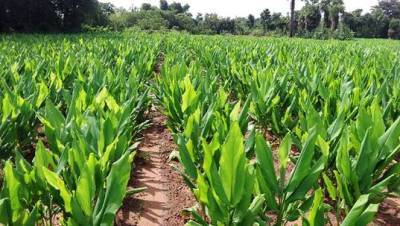MUMBAI, 12 April 2024: Turmeric, the vibrant golden spice revered for its flavor and medicinal properties, thrives in the warm, tropical climate of Maharashtra.
The state boasts a rich history of turmeric cultivation, contributing significantly to India's position as the world's largest producer. If you're considering venturing into turmeric farming in Maharashtra, this guide provides a roadmap to success, outlining opportunities, government support, and essential steps for establishing your own farm.
Maharashtra's Turmeric Landscape
Maharashtra offers diverse agroclimatic zones, making it suitable for cultivating various turmeric varieties. Districts like Sangli, Nanded, Amravati, and Buldhana are prominent turmeric producers, with the "Lakhadi" variety being the most widely grown. According to the Directorate of Agriculture, Maharashtra (2023), the state's annual turmeric production stands at approximately 3.8 lakh tonnes. This translates to an average yield of 3.2 tonnes per hectare, with some regions achieving even higher yields under optimal conditions.
Opportunities in Turmeric Farming
Turmeric farming presents several attractive prospects for aspiring agriculturists in Maharashtra:
-
High Demand: Turmeric enjoys domestic and international popularity. India is the world's largest consumer, utilizing turmeric in culinary and medicinal applications. Additionally, there's a healthy export market with countries seeking high-quality Indian turmeric for various uses.
-
Profitability: Cultivating turmeric can be a lucrative venture, with a good market price fetching substantial profits for farmers. The profit margin can vary depending on factors like yield, quality, processing, and market fluctuations.
-
Government Support: The Maharashtra government recognizes the importance of turmeric farming and offers various schemes to support cultivators. These include subsidies on seeds, fertilizers, and irrigation equipment, along with technical guidance and training programs.
Setting Up Your Turmeric Farm
Here's a step-by-step guide to establishing your turmeric farm in Maharashtra:
1. Site Selection and Land Preparation:
- Choose well-drained, fertile land with a loamy or sandy loam soil texture.
- Ideal pH range for turmeric is between 6.0 and 7.5. Conduct a soil test to determine any necessary amendments.
- Ensure proper drainage to prevent waterlogging, detrimental to turmeric growth.
- Prepare the land by deep ploughing and harrowing to create a fine tilth.
2. Selecting the Right Turmeric Variety:
- The "Lakhadi" variety is the most popular choice in Maharashtra due to its high curcumin content (the active ingredient) and good market demand.
- Other options include "Sangli Turmeric," "姜黄 (Jian Huang)" (Chinese turmeric), and "Raja." Consult with local agricultural departments or experienced farmers for advice on the most suitable variety for your location and market.
3. Planting Material and Sowing:
- Turmeric is not grown from seeds but from "rhizomes," the underground stem of the turmeric plant.
- Select healthy, disease-free, and mature turmeric rhizomes with well-developed buds ("eyes").
- Before planting, cut the rhizomes into pieces with at least one or two buds each.
4. Planting:
- The ideal planting season in Maharashtra is between April and May, coinciding with the pre-monsoon showers.
- Plant the turmeric rhizome pieces with the "eyes" facing upwards at a depth of 6-8 cm.
- Maintain a spacing of 20-25 cm between plants within rows and 45-50 cm between rows.
5. Crop Management:
- Irrigation: Turmeric requires moderate irrigation, particularly during dry spells. However, avoid overwatering, which can lead to rot.
- Weed Control: Regular weeding is crucial to prevent competition for nutrients and moisture.
- Fertilization: Apply well-decomposed organic manure like compost or vermicompost at planting and during the growing season. Consult an agricultural expert for specific fertilizer recommendations based on your soil analysis.
6. Harvesting and Post-Harvest Management:
- Turmeric harvesting typically occurs 7-9 months after planting, depending on the variety and climatic conditions.
- Signs of maturity include yellowing and drying of leaves.
- Carefully dig up the turmeric rhizomes using a spading fork to avoid damaging the crop.
- After harvesting, clean and dry the turmeric thoroughly in the shade to prevent rot.
- Curing is essential for enhancing color, flavor, and shelf life. This involves keeping the turmeric in a well-ventilated shed for a few weeks at a specific temperature and humidity.
- Turmeric can be stored for several months under proper storage conditions (cool, dry, and well-ventilated).
Image credit: iiaasd.com




















